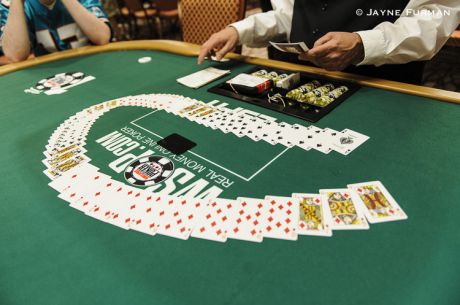How to Select Starting Hands in No-Limit Hold’em

Earlier this week in an article titled “Play Poker Without Looking at Your Cards? It Can Be Eye-Opening,” Martin Harris discussed the importance of position and stack sizes in no-limit hold’em tournaments, and how in some cases the hand you are dealt isn’t necessarily the most important factor influencing how you might want to proceed.
Of course, it is also important first to have an understanding of the relative strengths of starting hands in no-limit hold’em. This is particularly true for players who are just getting started with the game who might find themselves playing way too many hands or way too few hands, not having developed a ground-level knowledge of how starting hands compare.
PokerNews Editor-in-Chief Donnie Peters offers a quick introduction to some of the factors you want to consider when selecting starting hands in no-limit hold’em:
As explained in the video, one factor affecting starting hand selection is the number of opponents at the table. With full-ring (nine- or ten-handed) games it is often necessary to tighten up your starting hand requirements, whereas in short-handed games (six-handed, four-handed, heads-up) you’ll want to be looser and play more hands.
Also briefly touched on are certain hand groups like big pocket pairs, hands with two Broadway cards (i.e., ace through ten), and suited hands, all of which can be playable given your position and your opponents’ styles.
The biggest pocket pairs (aces, kings, queens, and jacks) are generally always playable, while discretion sometimes needs to be used when playing middle and lower pairs, particularly in the face of a lot of preflop aggression from others.
Ace-king, ace-queen, and king-queen are often good starters that can make top pair/top kicker hands, while other hands containing two Broadway cards can sometimes fall into the category of “trouble hands” that aren’t always so easy for beginners — or even experienced players — to play postflop.
Suited aces — e.g., A♥9♥, A♠7♠ — can make nut flushes, while other hands like suited connectors and suited one-gappers can be potentially profitable, too, especially if you can see a flop cheaply with them.
Probably the most important element worth recognizing for new players when it comes to starting hand selection, though, is to realize how a large percentage of the hands you’re dealt in no-limit hold’em isn’t necessarily playable on the basis of their value preflop or potential to make strong hands postflop.
In other words, while you might occasionally play “trash” hands like 10♠6♦, J♣4♣, K♦6♥, and so on based on position, stack sizes, or your read of an opponent being tight and/or weak, you generally will toss such hands away and only get involved with stronger holdings.
In fact, for beginning players especially, it isn’t a bad practice simply to limit oneself to the better starting hands, particularly when out of position or facing a raise.









